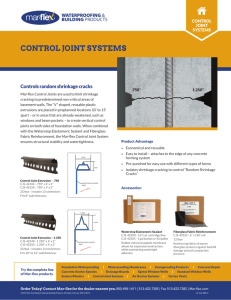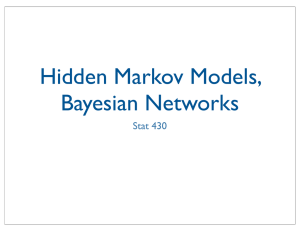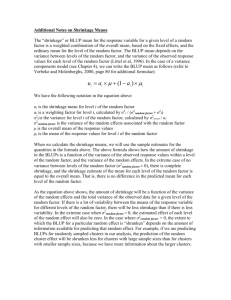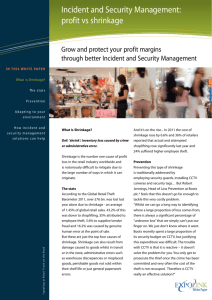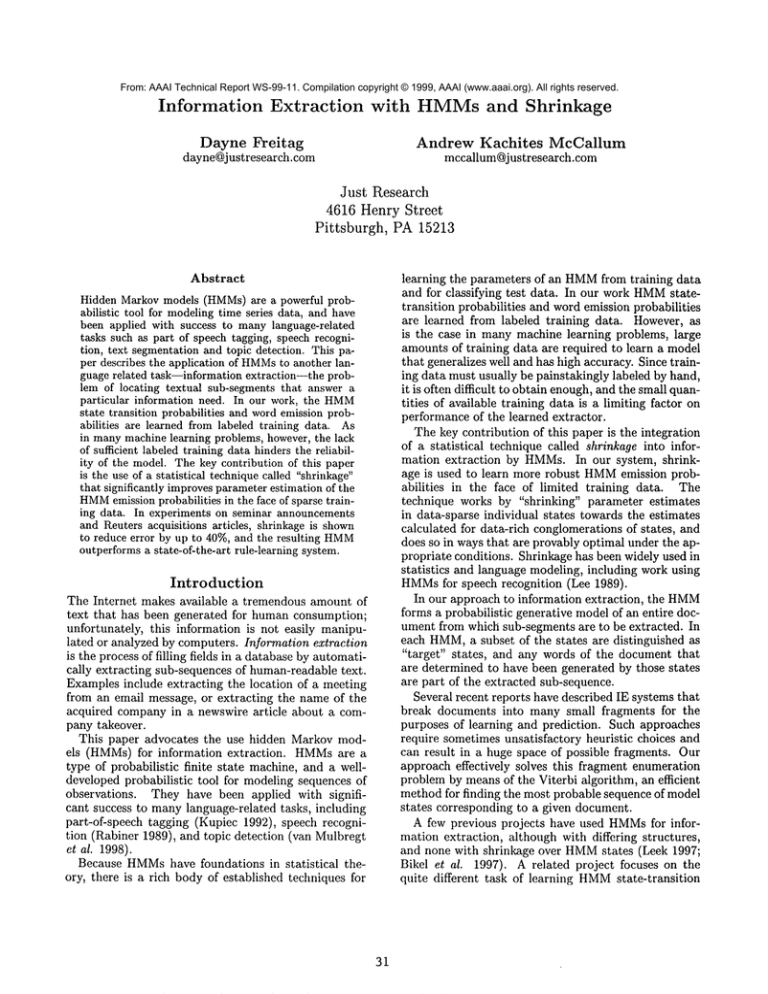
From: AAAI Technical Report WS-99-11. Compilation copyright © 1999, AAAI (www.aaai.org). All rights reserved.
Information
Extraction
with HMMsand Shrinkage
Dayne Freitag
dayne@justresearch.com
Andrew
Kachites
McCallum
mccallum@justresearch.com
Just Research
4616 Henry Street
Pittsburgh,
PA 15213
Abstract
learning the parameters of an HMM
from training data
and for classifying test data. In our work HMM
statetransition probabilities and word emission probabilities
are learned from labeled training data. However, as
is the case in many machine learning problems, large
amounts of training data are required to learn a model
that generalizes well and has high accuracy. Since training data must usually be painstakingly labeled by hand,
it is often difficult to obtain enough, and the small quantities of available training data is a limiting factor on
performance of the learned extractor.
The key contribution of this paper is the integration
of a statistical technique called shrinkage into information extraction by HMMs.In our system, shrinkage is used to learn more robust HMM
emission probabilities
in the face of limited training data. The
technique works by "shrinking" parameter estimates
in data-sparse individual states towards the estimates
calculated for data-rich conglomerations of states, and
does so in ways that are provably optimal under the appropriate conditions. Shrinkage has been widely used in
statistics and language modeling, including work using
HMMs
for speech recognition (Lee 1989).
In our approach to information extraction, the HMM
forms a probabilistic generative model of an entire document from which sub-segments are to be extracted. In
each HMM,a subset of the states are distinguished as
"target" states, and any words of the document that
are determined to have been generated by those states
are part of the extracted sub-sequence.
Several recent reports have described IE systems that
break documents into many small fragments for the
purposes of learning and prediction. Such approaches
require sometimes unsatisfactory heuristic choices and
can result in a huge space of possible fragments. Our
approach effectively solves this fragment enumeration
problem by means of the Viterbi algorithm, an efficient
method for finding the most probable sequence of model
states corresponding to a given document.
A few previous projects have used HMMsfor information extraction, although with differing structures,
and none with shrinkage over HMM
states (Leek 1997;
Bikel et al. 1997). A related project focuses on the
quite different task of learning HMM
state-transition
Hidden Markov models (HMMs)are a powerful probabilistic tool for modelingtime series data, and have
been applied with success to manylanguage-related
tasks such as part of speech tagging, speech recognition, text segmentation and topic detection. This paper describes the application of HMMs
to another language related task--information extraction--the problem of locating textual sub-segments that answer a
particular information need. In our work, the HMM
state transition probabilities and wordemission probabilities are learned from labeled training data. As
in manymachinelearning problems, however, the lack
of sufficient labeled training data hinders the reliability of the model. The key contribution of this paper
is the use of a statistical techniquecalled "shrinkage"
that significantly improvesparameter estimation of the
HMM
emission probabilities in the face of sparse training data. In experiments on seminar announcements
and Reuters acquisitions articles, shrinkage is shown
to reduce error by up to 40%, and the resulting HMM
outperformsa state-of-the-art rule-learning system.
Introduction
The Internet makes available a tremendous amount of
text that has been generated for human consumption;
unfortunately, this information is not easily manipulated or analyzed by computers. Information extraction
is the process of filling fields in a database by automatically extracting sub-sequences of human-readable text.
Examples include extracting the location of a meeting
from an email message, or extracting the name of the
acquired company in a newswire article about a company takeover.
This paper advocates the use hidden Markov models (HMMs)for information extraction.
HMMsare
type of probabilistic finite state machine, and a welldeveloped probabilistic tool for modeling sequences of
observations. They have been applied with significant success to many language-related tasks, including
part-of-speech tagging (Kupiec 1992), speech recognition (Rabiner 1989), and topic detection (van Mulbregt
et al. 1998).
Because HMMshave foundations in statistical
theory, there is a rich body of established techniques for
31
structure for information extraction (Seymore, McCallum, & Rosenfeld 1999).
Wedescribe experiments on two real-world data sets:
on-line seminar announcements and Reuters newswire
articles on company acquisitions.
Results show that
shrinkage consistently improves the performance over
absolute discounting.
A representative
HMMoutperforms a state-of-the-art
rule-learning system on
seven of nine extraction tasks.
(b)
(a)
HMMs for
Information
Extraction
Supposewe are given the task of extracting the purchasing price from each documentin a collection of articles
describing corporate acquisitions. Wecan imagine that
a given article is the result of a stochastic process involving two unigram language models: a background model
that typically emits tokens like ’that’ and ’said’; and a
model specific to prices that typically emits tokens like
’$’ and ’million’. To generate a document, the process
emits tokens from the background model, at some point
switching to the price model for a few tokens, then returning to the background model to complete the document. Slightly more realistically,
there might be a
number of specialized models from which the process
draws, some of them devoted to the context of the purchasing price, models responsible for prefix fragments
like "purchased XYZCorp for".
HMMsrepresent precisely this kind of process. A
HMM
is a finite state automaton with stochastic state
transitions and symbol emissions (Rabiner 1989). The
automaton models a probabilistic generative processes
whereby a sequence of symbols is produced by starting
at a designated start state, transitioning to a new state,
emitting a symbol selected by that state, transitioning
again, emitting another symbol--and so on until a designated final state is reached. Associated with each of
a set of states, S = {sl,.-. ,sn), is a probability distribution over the symbols in the emission vocabulary
V = {wl, w2, ...wn}. The probability that state sj will
emit the vocabulary item w is written P(wlsj). Similarly, associated with each state is a distribution over its
set of outgoing transitions. The probability of moving
from state s~ to state sj is written P(sjlsi).
Model transition and emission probabilities can be
learned from training data. When the training sequences are sufficiently labeled so as to be associated
with a unique path of states, the probabilities can be
calculated straightforwardly with ratios of counts (max°
imumlikelihood) or smoothed ratios of counts (maximuma posteriori).
Given a model and all its parameters, information
extraction is performed by determining the sequence
of states that was most likely to have generated the
entire document, and extracting the symbols that were
associated with designated "target" states.
To perform extraction we therefore require an algorithm for finding the most likely state sequence given a
HMMmodel M and a sequence of symbols. Although
a naive approach to finding the most likely sequence
(c)
Figure 1: Three example topologies.
would take time exponential in the sequence length, a
dynamic programming solution called the Viterbi algorithm solves the problem in just O(TN2) time, where
T is the length of the sequence and N is the number
of states in M. Thus the Viterbi algorithm executes
with time linear in the length of the sequence--much
more efficiently than several other information extraction approaches that evaluate a super-linear number of
sub-sequences.
The models we use for information extraction have
the following characteristics:
¯ Each HMM
extracts just one type of field (such as
"purchasing price"). Whenmultiple fields are to be
extracted from the same document (such as "purchasing price" and "acquiring company"), a separate
HMM
is constructed for each field.
¯ They model the entire document, and thus do not require pre-processing to segment document into sentences or other pieces. The entire text of each training documentis used to train transition and emission
probabilities.
¯ They contain two kinds of states, background states
and target states. Target states are intended to produce the tokens we want to extract.
¯ They are not fully connected. The restricted transition structure captures context that helps improve
extraction accuracy. State-transition topology is set
by hand, not learned from training data.
Figure 1 shows three example topologies. The model
in Figure l(a) is the simplest possible topology. In practice, of course, we expect that context around the target
state to provide important clues in the search for target
text. Wecan exploit someof these clues by adding prefix and suffix states, as in Figure l(b). Similarly, target
fragments can vary in length, and certain tokens may
be more commonat the beginning or end of the fragments. If the object is to extract the name of a company
for example, the tokens "Inc" and "Corp" are almost
certainly at the end of a fragment. Wecan attempt to
capture such structure by expanding the single target
32
state into an array of parallel paths of varying length.
The final state in the longest such path includes a selftransition, in order to account for unusually long target
fragments. Figure 1(c) shows a set of target paths
lengths one to three.
Figure 1 illustrates the two topological parameters we
experiment with, context windowsize and target path
count. The window size is the number of prefix and
suffix states. The model in Figure l(b) has a window
size of four. Of course, nothing requires that a model
have the same number of prefix and suffix states; we
assume this for simplicity. The path count is the number of parallel, length-differentiated, sequential target
paths. If the path count is P, then a model has P target paths, varying in length from one to P. The model
in Figure l(b) has a path count of one; the model
Figure 1(c) has a path count of three.
In order to train a model, each token in a documentis
labeled according to whether it is part of the target text.
Werequire that only target states emit such tokens, and
only non-target states emit non-target tokens. Given
this constraint, and a particular non-empty document,
only a single, unambiguouspath is possible through any
of the topologies in Figure 1.
Estimating
Emission Probabilities
Whenthe emission vocabulary is large with respect to
the number of training examples, maximumlikelihood
estimation of emission probabilities will lead to poor estimates, with many words inappropriately having zero
probability. The use of a well-chosen prior in conjunction with maximuma posteriori or Bayes optimal estimation will prevent zero-probability estimates and improve estimation overall.
For example, Bayes optimal parameter estimation in
conjunction with a uniform Dirichlet prior results in
the widely used Laplace smoothing, in which the count
of every word in the vocabulary in incremented by a
single extra "priming" occurrence. This is also known
as additive smoothing. An alternative smoothing technique that performs better when the number of zerocount words varies widely from state to state is absolute discounting. This method subtracts a fixed discount, 0 < d < 1 from all words with count greater
than zero. The resulting available probability mass is
then distributed over all words that have zero count according to someprior distribution (in our case uniform).
Thus we have
N w,s -d ¯
P(w[s)
~,, If
= d’(lY]-fz°
z~I
0
N(w, s)
) N(ws~ - O. (1
,
~ , / --
where IV[ is the size of the vocabulary, N(w, s) is the
number of times w occurs in the training data for state
s, N(s) is the total number of word occurrences across
all words in training data for state s, and [Zs[ is the
number of unique words with zero count in state s.
There is no closed-form solution for the optimal value
of d. A typical choice is z(s, 1)/(z(s, 1) + 2- z(s, 2)),
33
where z(s, n) is the number of unique words in state s
with count n.
Both Laplace smoothing and absolute discounting calculate the word distribution in a state using only the
training data in state s itself. In the next section, we
discuss shrinkage, a methodthat leverages the word distributions in several related states in order to improve
parameter estimation.
Shrinkage
In many machine learning tasks there is a tension between constructing complex models with many states
and constructing simple models with only a few states.
The complex model is able to represent intricate structure of the task, but often results in poor (high variance) parameter estimation because the training data
highly fragmented. The simple model results in robust
parameter estimates, but performs poorly because it is
not sufficiently expressive to model the data (too much
bias).
Shrinkage is a statistical
technique that balances
these competing concerns by "shrinking" parameter estimates from data-sparse states of the complex model
toward the estimates in related data-rich states of the
simpler models. The combination of the estimates
is provably optimal under the appropriate conditions.
Shrinkage has been extensively studied in statistics
(Carlin & Louis 1996). Versions of this technique are
also used widely in statistical
language modeling for
speech recognition. Weemploy a simple form of shrinkage that combines the estimates with a weighted average, and learns the weights with Expectation Maximization. In speech recognition this form is called deleted
interpolation (Jelinek & Mercer 1980).
Shrinkage
Extraction
for
HMMs and Information
Shrinkage is typically defined in terms of some hierarchy that represents the expected similarity between
parameter estimates, with the estimates at the leaves.
To create a hierarchy from an HMM,we define subsets
of states that have word emission distributions we expect to be similar, and declare them to share a common
"parent" in a hierarchy of word distributions.
Figure 2 shows such a hierarchy. It depicts, for example, that all prefix states are expected to have related
word distributions--reflecting
also the fact that in a
simpler model, all four prefix states might have been
represented by a single state that allowed up to four
self-transitions. Internal nodes of the hierarchy can also
have parents, reflecting expectations about weaker similarity between groups of states, and representing HMM
emission distributions that are yet again more simple.
At the top of each hierarchy is the most unassuming of
all word distributions, the uniform distribution, which
gives all words in the vocabulary equal probability. Because the uniform distribution is included we no longer
Utl~Jtnl [~
1. The new, shrinkage-based estimate for the probability of word w in state sj is written ~)(w[sj), and is the
weighted average:
gh~bal.~
.,"" i
i
conte~
..."’"
...... .’.’.~:’":’ "
i ...........
~
k
= AjP(wlsj).
.:2 ’.."::::: ......
(2)
i=1
Determining Mixture Weights
Figure 2: A shrinkage configuration that addresses data
sparsity in contextual states, showingshrinkage only for
non-target states.
need to smooth the local estimates with Laplace or absolute discounting¯
Wehave compared several shrinkage hierarchy configurations. Given that we distinguish four classes of
states: non-target, target, prefix, and suffix, the four
shrinkage configurations are described as follows:
¯ None. No shrinkage;
used.
only absolute
discounting
is
¯ Uniform. Instead of absolute discounting, all singlestate distributions are shrunk toward the uniform distribution.
E-step Calculate the degree to which each node predicts the wordsin state sj’s held-out set, 7/j:
¯ Global. The distributions of all target states are
shrunk toward a commonparent, as well as the uniform distribution; likewise for the non-target states
with a different parent.
¯ Hierarchical. (Shown in Figure 2.) Target distributions are handled in the same way as in global.
Each of the other classes of states--non-target, prefix,
and suffix--is shrunk toward a separate, class-specific
parent. The prefix and suffix parents are furthermore
shrunk toward a shared "context" grandparent. Finally, all non-target, prefix, and suffix states are also
shrunk toward a single ancestor, shared among all
states that are not target states. Again, every state
is also shrunk toward the uniform distribution.
Shrinkage-Based
Wederive empirically optimal weights, )~i, between the
ancestors of state s j, by finding the weights that maximize the likelihood of some hitherto unseen "held-out"
data, 7-/. This maximumcan be found by a simple form
of Expectation-Maximization (EM) (Dempster, Laird,
& Rubin 1977), where each each word is assumed to
have been generated by first choosing one of the hieri (with probtarchy nodes in the path to the root, say s
ability A~), then using that node’s word distribution to
generate that word. EMthen maximizes the total likelihood when the choices of nodes made for the various
words are unknown¯EMbegins by initializing
the Aj’s
to some initial values, sayJ )~/.
=
1,
then
iterating
the
¯
followmg
two steps until the 3Aj’s ~o not change:
i
i
~jP(wtls~
~ = E ~-]mAmp(w~lsT
wtET-lj
3
(3)
J
M-step Derive new (and guaranteed improved) weights
by normalizing the ~’s:
A} -
5-"
.~
z---~m’-3
(4)
While correct and conceptually simple, this method
makes inefficient use of the available training data by
carving off a held-out set. Wefix this problem by evaluating the E-step with each individual word occurrence
held out in turn. This method is very similar to the
"leave-one-out" cross-validation commonlyused in statistical estimation.
Word Probabilities
Experiments
Our new, shrinkage-based parameter estimate in a leaf
of the hierarchy (state of the HMM)
is a linear interpolation of the estimates in all distributions from the leaf
to its root. Local estimates are calculated from their
training data by maximumlikelihood (simple ratios of
counts, with no additions or discounting). The training
data for an internal node of the hierarchy is the union
of all the data in its children.
We write the word probability
estimates
for
the nodes on the path starting
at state Sj as
{p(w]sO), e(w]sj),
1
...e(wIs ki )}, where P(wIs°) is the estimate at the leaf, and P(w[sk) is the uniform distribution at the root. The interpolation weights amongthese
k iAj =
k }, where ~i=1
estimates are written{Aj,
0 Aj,
1 ...Aj
Wepresent experimental results on nine information
extraction problems from two corpora: a collection of
seminar announcements posted to local newsgroups at
a large university, and a collection of articles describing
corporate acquisitions taken from the Reuters dataset
(Lewis 1992). Both of these datasets, as well as the
problems defined for them, are described in detail in
previously published work (Freitag 1999).
The performance of an algorithm is measured document by document. If the task is to extract the start
time of a seminar from an announcement, we assume
that there is a single correct answer (perhaps presented
several different times in the same or superficially different ways). Weask whether a learner’s single best
34
Window = 1
Window = 4
Window = 10
speaker
0.431
0.460
0.363
location
0.797
0.653
0.558
stime
0.943
0.960
0.967
etime
0.771
0.716
0.746
Distance
1
2
3
4
Table 1: Effect on F1 performance of changing "window" size (number of context states) on four seminar
announcement fields under absolute discounting.
None
Uniform
Global
Hier.
speaker
0.460
0.499
0.558
0.531
location
0.653
0.660
0.758
0.695
stime
0.960
0.971
0.984
0.976
speaker
0.84
0.81
0.73
0.65
location
0.84
0.90
0.80
0.74
stime
0.92
0.98
0.85
0.86
etime
0.95
0.98
0.95
0.93
Table 3: Local mixture weights along the prefix path
as a function of distance from the target states.
etime
0.716
0.840
0.589
0.565
None
Uniform
Global
Hier.
speaker
0.513
0.614
0.711
0.672
location
0.735
0.776
0.839
0.850
stime
0.991
0.991
0.991
0.987
etime
0.814
0.933
0.595
0.584
Table 2: Effect on F1 performance of different shrinkage configurations on four seminar announcementfields,
given a topology with a windowsize of four and a single
target state.
Table 4: Effect on F1 performance of different shrinkage configurations on four seminar announcementfields,
given a topology with a windowsize of four and four
parallel length-differentiated target paths.
prediction exactly identifies one of the fragments representing the start time. If a learner’s best prediction does
not align exactly with an actual start time, as identified
by the humanlabeler, it is counted as an error.
Let C be the number of test documents for which a
learner’s best prediction correctly identifies an instance
of the target field. Precision (P) is C divided by the
number of documents for which the learner issues any
prediction. Recall (R) is C divided by the number of
documents actually containing an instance of the target
field. Wepresent results in terms of F1, which is the
harmonic mean of P and R, i.e. 2/(1/P + l/R).
Weassume that context is necessary for correct extraction on most IE tasks, but we do not know, given
a particular
problem, how much a HMM
can exploit.
Table 1 explores the effect on F1 performance of window sizes 1, 4, and 10 on the four extraction tasks
from the seminar announcement domain when only absolute discounting is used to estimate emission probabilities.
Note that between the smallest and largest
window size performance actually decreases on three
of the four problems, reflecting the fact that the more
complex model fractures the training data, making it
more difficult to obtain reliable parameter estimates.
By softening the dependence of emission estimates on
relative position, shrinkage allows the model to make
improved use of larger windowsizes. Table 2 shows the
effect of shrinkage on performance of a window-size-four
topology. For all fields one or more of the shrinkage configurations out-performs absolute discounting. In some
cases the improvementis dramatic; for example shrinkage reduces error on the speaker field by 40%."Global"
shrinkage is best for three of the four fields. Weattribute the large performance differences on the etime
task to the relative infrequency of this field. Although
times in general are prevalent in the seminar announcement corpus, only about half of the documents contain
a seminar end time. The decrease in F1 for the bottom
two shrinkage configurations is due to a large number
of spurious predictions, extractions from documents in
which no end time is present. Thus, by making sparsely
trained states more willing to emit tokens they haven’t
seen in training, shrinkage can sometimes have a deleterious effect.
It is interesting to ask howthe distribution of mixture weights varies as a function of a state’s role in the
model. Table 3 shows, for sample runs on each of the
four seminar announcement tasks, how much weight is
placed on the local token distribution of each of four
prefix states. The "global" shrinkage configuration is
used in this case. Note how the local weight tends to
decline with increasing distance from the target text,
agreeing with our intuition that the most consistent
patterns are the closest. Also, local weight decreases
in proportion to the difficulty of the field, as reflected
in F1 results. Clearly, the two time fields tend to occur
in very predictable contexts.
The combination of shrinkage with multiple target
paths is particularly
powerful. Table 4 shows the
effect of the various shrinkage configurations on the
performance of the network of Table 2 in which the
single target state is replaced by four parallel target
paths of lengths one, two, three, and four. Compared
with the earlier model, we see a universal increase in
performance--a 27%increase in performance on the location field. On this field, the performance of the HMM
is far better than other non-HMM
learning methods we
have seen.
The combination of shrinkage with appropriately designed topologies yields a learning algorithm that is
based on sound statistical principles, runs efficiently,
and performs at a level competitive with or better than
the best learning algorithms with which we have experimented. Table 5 compares HMMperformance on
35
SRV
HMM
SRV
HMM
speaker
location
0.703
0.723
0.711
0.839
acquired purchaser
0.343
0.429
0.309
0.481
slime
0.988
0.991
acqabr
0.351
0.401
etime
0.839
0.595
dlramt
0.527
0.553
estimates. However, unlike our shrinkage, which averages among different HMM
states, they average among
distributions that use different representations of the
last emission. They also do not learn the optimal mixture weights with EM.
status
0.380
0.467
Conclusions
Table 5:F1 of SRVand a representative
HMM
on nine
fields from two domains, the seminar announcements
and corporate acquisitions.
This paper has demonstrated the ability of shrinkage
to improve the performance of HMMsfor information
extraction. The tension between the desire for complex models and the lack of training data is a constant
struggle here (as in manymachine learning tasks) and
shrinkage provides for us a principled methodof striking a balance. Wehave also strived to motivate the
high suitability of HMMs
to the information extraction
task in general--for example, by pointing out that the
availability of the Viterbi algorithm avoids the need to
evaluate a super-linear number of sub-sequences.
nine information extraction problems with that of SRV,
a consistently strong rule-learning algorithm described
elsewhere (Freitag 1999). The model in question has
context windowsize of four, four target paths, and uses
the global shrinkage configuration. On all but etirae
and acquired, the HMM
obtains a higher F1 score than
SRV. Note, however, that on etime the performance of
the uniform shrinkage configuration does beat SRV(see
Table 4).
Related
References
Bikel, D. M.; Miller, S.; Schwartz,R.; and Weischedel,R.
1997. Nymble:a high-performance learning name-finder.
In Proceedings of ANLP-97,194-201.
Carlin, B., and Louis, T. 1996. Bayesand Empirical Bayes
Methods for Data Analysis. Chapmanand Hall.
Dempster, A.; Laird, N.; and Rubin, D. 1977. Maximumlikelihood from incomplete data via the EMalgorithm. Journal of the Royal Statistical Society 39(B):1-38.
Freitag, D. 1999. Machine Learning for Information
Extraction in Informal Domains. Ph.D. Dissertation,
Carnegie MelonUniversity.
Jelinek, F., and Mercer, R. 1980. Interpolated estimation
of Markovsource parameters from sparse data. In Gelsema,
S., and Kanal, L. N., eds., Pattern Recognitionin Practice,
381-402.
Kupiec, J. 1992. Robust part-of-speech tagging using a
hidden Markov model. Computer Speech and Language
6:225-242.
Lee, K.-F. 1989. Automatic Speech Recognition: The Development of the SPHINXSystem. Kluwer AcademicPublishers.
Leek, T. R. 1997. Information extraction using hidden
Markovmodels. Master’s thesis, UCSan Diego.
Lewis, D. 1992. Representation and Learning in Information Retrieval. Ph.D. Dissertation, Univ. of Massachusetts.
CS Tech. Report 91-93.
Rabiner, L. 1989. A tutorial on hidden Markovmodelsand
selected applications in speech recognition. Proceedingsof
the IEEE77(2).
Seymore, K.; McCallum, A.; and Rosenfeld, R. 1999.
Learning hidden markov model structure for information
extraction. Submitted to the AAAI-99Workshopon Machine Learning for Information Extraction.
van Mulbregt, P.; Carp, I.; Gillick, L.; and Yamron,J.
1998. Text segmentation and topic tracking on broadcast
news via a hidden markov model approach. In Proceedings of the International Conference on Spoken Language
Processing.
Work
HMMs
are well suited to a range of language processing
tasks and have previously been applied to the problem
of information extraction in ways that differ from our
approach in various ways.
In a related project, Seymore, McCallum, & Rosenfeld present an effort to learn HMMs
state/transition
structure 1999. Unlike this paper, the approach uses a
single HMM
to extract many fields which are densely
packed in moderately structured text (such as research
paper references and headers). Since many fields must
be represented in a single HMM,all observed and expected relative orderings of the fields must be captured,
and structure learning becomes a challenging and necessary task.
Leek applies HMMs
to the problem of extracting gene
locations from biomedical texts (Leek 1997). In contrast with the models we study, Leek’s models are carefully engineered for the task at hand--both the general
topology (which is hierarchical and complex), and the
language models of individual states. Leek uses network topology to model natural language syntax and
trims training examples for presentation to the model.
States are unigram language models, as in our work, but
it is unclear what smoothing policy is used. Unknown
tokens are handled by special "gap" states.
The Nymble system (Bikel et al. 1997) uses HMMs
to perform "named entity" extraction as defined by
MUC-6.All different fields to be extracted are modeled in a single HMM,
but to avoid the resulting difficult structure-learning problem, there is a single state
per target and the state-transition
structure is completely connected. Emission and transition probabilities are conditioned not only on the state, but also on
the last emission--resulting in highly fragmented probability functions, and sparse training data. Thus they
use a form of shrinkage to obtain more robust parameter
36


